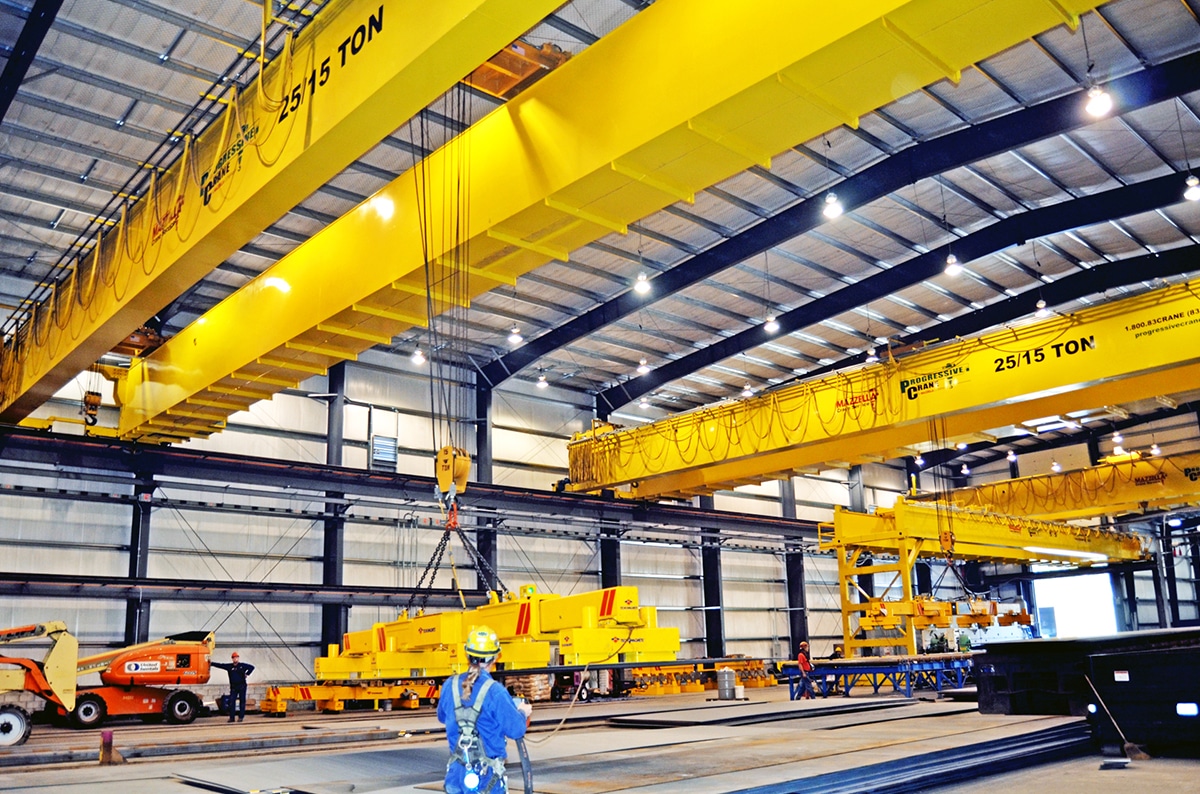In a contemporary production facility, overhead bridge cranes are one of the most crucial pieces of equipment. Overhead cranes are sometimes known as overhead bridge cranes or bridge cranes. The term EOT, which stands for Electric Overhead Traveling Crane, is also used to refer to them. EOT crane is a typical abbreviation used in government and military bid specifications for overhead cranes.
An overhead crane is distinguished by parallel runways with a bridge beam spanning the gap between the runways, regardless of the precise phrase you choose. The overhead crane’s hoist is suspended from the bridge beam by a cart and moves between the overhead crane system’s runways.
Table of Contents
Custom and standard overhead bridge crane:
Both single and double girder overhead bridge cranes are offered. One girder supports a trolley and a hoist in single girder bridge cranes. The added support of two bridge girders allows double girder bridge cranes to give more space than single girder cranes.
Applications of overhead bridge crane
Bridge cranes are suited for a wide range of applications due to their varied design options and large lifting capabilities. Among the most important industries are:
Metal Refining:
Throughout the manufacturing process, overhead cranes handle raw materials and workpieces.
Automotive Manufacturing:
Bulky moulds, components, and raw materials necessitate the use of overhead cranes.
Paper Milling:
Bridge cranes are often used in paper mills to install equipment, perform normal maintenance, and build paper machines from the ground up.
Our team proudly meets duty cycle criteria, having over 45 years of expertise in the material handling business. To understand more about our crane systems and products, please visit our website.
Overhead Bridge Crane End trucks:
The end trucks are located on both ends of the bridge beam. They serve as a link between the bridge beam and the building, as well as the wheels on which the crane travels. These wheels are mounted on the runway beam and give access to the whole length of the structure.
Overhead Bridge Crane Bridge Girder(s)
The hoist is supported by the crane bridge’s horizontal beam. There can be one or two bridge beams, but it will be discussed in a later issue.
Principles of an overhead bridge crane:
The crane bridge’s main horizontal beam supports the trolley and is supported by the end trucks.
Trolleys Hoist
Both the hoist and the trolley frame are included in one set. Both hoists can be supplied on a single trolley or on separate trolleys in circumstances when more than one hoist is required on a single crane.
Hoist:
The hoist is attached to the trolley and uses a hook or lifting attachment to conduct the actual lifting. Hoists can be divided into two categories. Munck is a wire rope hoist that is extremely durable and will provide years of service. The Chain Hoist is the other type of hoist.
Trolley:
The hoist is transported across the building on a trolley. It travels along the girder of the bridge, absorbing lateral motion. Keep in mind that the lengthwise motion is the bridge motion.
Runway:
The grey item in the picture is the runways. They provide a smooth surface for the bridge cranes to travel over the length of the structure. The terms “bridge crane,” “overhead crane,” and “overhead bridge crane” are all used to refer to the same object.
Under running overhead bridge cranes:
For systems with a lower capacity, underrunning overhead cranes are commonly used. The bridge is attached to end trucks in this configuration, which feature pairs of wheels on the top edge. These wheelsets then run down the runway beam’s bottom flange. Furthermore, like with Gorbel Systems, the wheels on end trucks are confined inside an enclosed track in underrunning workstation cranes.
The potential strength of the flange of the beam and the structure of this crane from which they are hanging limit the capacity of underrunning overhead cranes. Grab Overhead crane systems that are under running or underhung are popular because they can be hung from a building’s overhead or roof, conserving valuable floor space.
Because they can be suspended from a building’s ceiling or roof, under running or underhung overhead crane systems are popular because they save floor space that would otherwise be taken up by runway columns in a top running design.
The most frequent are top-running overhead cranes. They can be constructed to bear loads ranging from 1/8 to 160 tonnes. The bridge is attached to end trucks with wheels on the bottom side, which run along the bar or ASCE rail on the top of the runway system in this sort of overhead crane.
Conclusion:
Based on the architecture of the bridge with the overhead crane, overhead cranes are split into two types. This relates to the bridge’s architecture rather than the hoist’s position.
With single or double girder designs, overhead bridge cranes can be top running or under-hung. Grab Overhead Crane uses hoists and trolleys to move the weight both vertically and laterally. Cranes of this type can be a push, geared, or power.

